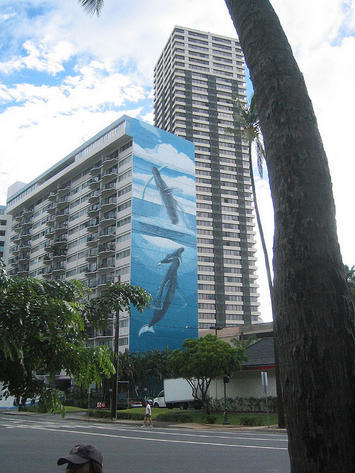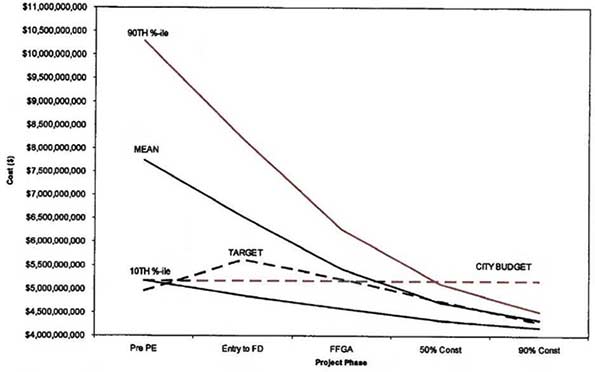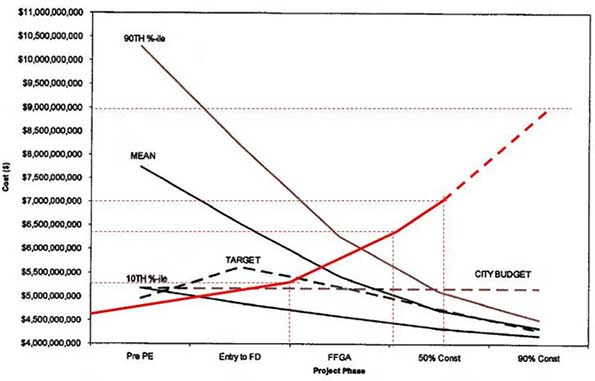
Typically very few people pay attention to the goings on in the small state of Hawaii. How bad can possibly things get there? Well, a lot of people recall Boston’s Big Dig, the nation’s largest infrastructure fiasco with a final price tag of about $15 billion. What if I tell you that tiny Honolulu is building a rail system that’s expected to cost at least one-half the cost of the Big Dig? On a per-capita basis it would be the nation’s largest infrastructure fiasco by far.
Honolulu rail, managed by Honolulu Area Rapid Transit (HART), is a 1970s style 20 mile, all-elevated heavy-rail guideway with third rail power delivery and light rail-sized cars limited to about 650 passengers per two-car combination; it has an ability to run only up to four cars for peak period service. It is the worst design possible because it combines an intrusive and expensive infrastructure including 21 elevated stations, and a low passenger carrying capacity with over 60% of it as standing passengers.
Despite the preponderance of evidence that Honolulu’s rail will do little to mitigate the severe congestion on the island of Oahu, the project did garner marginal (50.6%) public support on a 2008 referendum. Despite a couple major lawsuits, it completed the Federal Full Funding Grant Agreement process in 2012. Local political preference (e.g., why build a $1 Billion taxpayer project when you can get away with a $5 Billion project? … also known as “the gravy train”) stands among the major causes of this megaproject failure in progress.
What’s a megaproject failure? An infrastructure project that exhibits at least two out of three bad outcomes: 1) Large cost overruns, 2) Long project delivery delays, and 3) Much lower usage than forecast. Well known megaproject failures include the Chunnel Tunnel/Eurotunnel that suffered all three failures, and Boston’s Big Dig that suffered failures 1 and 2 in a big way. Tren Urbano in San Juan, Puerto Rico is a peer project that HART rail will likely match in failure-to-meet-targets. Tren Urbano’s actual construction cost was 80% over the planned estimate, and its ridership has been only one quarter of what was projected! HART rail and Tren Urbano were planned by the same consultant (PB) and had the same oversight (FTA.)
At the end of 2015, five miles of the HART guideway, and the rail yard appear to be substantially complete. HART, the voter approved “independent authority” that runs the project with many of its budget strings controlled by the city council, claimed a 25% project completion in December 2015, although 15% is a more realistic estimate based on what has been physically constructed so far. Several segments and columns have suffered large cracks, concrete delamination and segment misalignment [1], and safety lapses were alleged at the Ansaldo rail yard [2]. In less than two years, the guideway construction company (Kiewit) submitted 40 work change orders and recently demanded a $20 million price adjustment. But this is nothing compared to the total escalation of cost figures.
First, let’s review some highlights of the project’s development between 2004 and 2015.
- 2004: Newly elected mayor Hannemann asserts that 34 miles of rail will cost $2.7 Billion.
- Mid-2006: Hannemann switches to the Minimum Operating Segment: 20 miles will cost about $3 B.
- Late-2006: Alternatives Analysis sets the cost at $4.6 B (this figure and all figures below include FTA-mandated contingency funds).
- Spring 2008: Hawaii legislature approves a 0.5% tack-on to Hawaii’s GET tax that applies to every transaction. Against expectations, Republican Governor Linda Lingle opted to save her political career and let the tax stand without a veto. The rail tax is expected to generate about $2 B. The gravy train has thus been established.
- Summer 2008: Mayor Hannemann up for reelection gives a helicopter ride to Senator Oberstar who then says that the Feds will give Honolulu $900 M. Hannemann declares that “the train has left the station.”
- 2009: President pro tempore Senator Inouye of Hawaii joins the rail party. FTA is strong-armed to pay $1.55 B.
- 2010: The cost is up to $5.4 Billion not counting the error of locating an insufficient distance from an airport runway. A $150 M realignment is necessary to reroute the guideway one block over.
- 2010: Outgoing Governor Linda Lingle releases an independent financial analysis of the project by IMG and Thomas Rubin which concluded that construction cost will likely be more than the $5.4 B projection, ridership projections were both very high and would require passenger loads significantly higher than that of any U.S. transit operator, future rail renewal and replacement costs were ignored, operating subsidies were significantly understated, and many projected revenues were significantly overstated. Mayor Carlisle dismissed the report as “a product of rail opponents.”
- 2011: Mayor Carlisle performs a “ceremonial groundbreaking” but only utility relocation occurs afterwards. The project still aims for a 2019 completion.
- 2012: Both a National Environmental Policy Act (NEPA) and a Hawaiian burial ground desecration lawsuit are filed, the former in federal court the latter in state court. Only the second lawsuit causes minor construction restrictions in areas where archeological surveys had not been done.
- 2012: Construction accelerates at the casting yard and the first piers appear in the middle of prime agricultural land. The first four miles of the project are on agricultural land. Carlisle loses in the primary. Two Democrats, Kirk Caldwell (pro rail) wins the mayor race over past governor Ben Cayetano (anti rail.) Although some frame it as another victory for the rail project, Cayetano’s battles with unions during his eight years in the governor’s office were a major cause of his loss.
- Mid-2014: 9th Circuit court appeal ends unsuccessfully for the plaintiffs of a NEPA-based suit.
- December 2014: HART reveals a $910 projected deficit and asks for more tax monies.
- December 2015: HART proposes to open 10 miles of service in 2018.
One of the flaws in megaproject development is strategic misrepresentation, or cleverly worded lying to the public and decision makers such as the HART board members and the Honolulu city council members, none of whom have any expertise in large infrastructure projects and rail in particular. Project advocates such as the FTA turned a blind eye to facts and in 2009 they presented to the people of Hawaii Figure 1, a gem of strategic misrepresentation [4] which simply fit the political line that the proposed 20-mile rail will cost $4.6 billion as applicable during the 2008 rail referendum. Notice that the FTA cost development in Figure 1, line labeled MEAN, goes against decades of real world evidence of a project’s cost escalation as it moves from planning to construction (e.g., Dr. Bent Flybjerg’s summaries of infrastructure megaprojects [3]). This FTA-sponsored report contains one point of truth: There is a 10% chance that HART rail will cost about $10 B.

Figure 1. HART expected cost over time.
One would think that only three years into construction, with only about 15% of the project completed and only about half of the project gone to bid, HART would be sitting comfortably on a pile of money generated by a general excise tax surcharge being collected since 2007 (about $140 M per year) plus $1.55 B from the full funding grant agreement. Nothing could be further from the truth. In late 2014 HART announced a $910 M expected shortfall and successfully lobbied the Hawaii legislature to extend the 0.5% surcharge from end of 2022 to end of 2027.
In another move of strategic misrepresentation, rail planners pretended that the rail is like an electric car, e.g., one buys an EV, then goes homes and plugs it in. Likewise, HART builds rail, which plugs into the city grid for free. However, rail’s 30 MW to 50 MW power draw is a major requirement. The utility’s reaction was unpleasant for HART [5] which is now negotiating another expensive arrangement. The combined cost of substations, power generation and the (still in limbo) airport utility relocation tasks are likely to cost about $500 M bringing the known total to approximately $7 B with none of the 21 stations constructed nor the second half of the project gone to bid.
HART rail’s cost development is plotted in Figure 2. The second half of the project includes the challenging construction through urban Honolulu which is one of the densest US cities. There are now peripheral discussions to terminate the project at a large transit bus and handicapped van terminal at Middle Street, which is approximately at the 16th mile of the rail route. This is a welcome possibility because Honolulu will be spared of the heavy construction and debilitating lane and road closures at its downtown and near Waikiki which will be deleterious to general economic activity and tourism.

Figure 2. Actual and expected cost plot.
As the project cost creeps above $7 B (for a city of just one million people), with an expected payoff of about 1% in congestion reduction [6], and the dramatic re-arrangement of TheBus as a feeder to the rail [7], one can begin to outline some of the major consequences such as:
- Minimal ridership like Tren Urbano in San Juan, PR. Furthermore, San Juan’s average income and auto ownership are much lower to those of Honolulu (i.e., Honolulu has far fewer transit dependent commuters than San Juan.)
- Destruction of prime agricultural land on Oahu. After years in legal battles, the state Supreme Court approved B.R. Horton’s proposed 12,000 suburban Ho’opili development which includes two rail stations. Although HART makes a big deal out of Transit Oriented Development, Horton’s own EIS reveals that each station will generate the equivalent of only two busloads of passengers for the rail in the peak hour. This approval is proof that development that does not pass traffic congestion standards simply gets … a rail pass.
- The huge opportunity cost. With $7 B and counting, Honolulu could have actually reduced traffic congestion by more than 25% and reduced its dependency on oil by over 40%. Honolulu burns oil to produce electric power and as a result its electricity cost is 300% above US average. Instead of switching power generation and fleet fueling to natural gas, island policies emphasize oil-generated electric cars and electric trains!
Finally, looking at the bigger picture for Honolulu which includes a $5 B consent decree with the EPA for secondary sewer treatment, increasing dependency on imports, including 90% of food, with prices escalated by the Jones Act requirements, and the nation’s fifth worst unfunded pension liability according to The Economist [8], the future is worrisome: At best Honolulu will experience large increases in taxes and congestion, at worst those plus bankruptcy. One thing is certain. This textbook megaproject failure orchestrated by business interests and unions, supported by misguided environmentalism and enabled by enterprising politicians got Honolulu railroaded [9].
Panos D. Prevedouros is Professor and Chair, Department of Civil and Environmental Engineering, University of Hawaii at Manoa.
Photo by super-structure (Jason Coleman), "Honolulu Murals".
REFERENCES AND CLARIFICATIONS
[1] HawaiiNewsNow, Large Cracks Develop along Rail Line, http://www.hawaiinewsnow.com/story/28827333/large-cracks-develop-along-rail-line, 2015.
[2] HawaiiNewsNow, Rail Whistleblower Suit Filed, http://www.hawaiinewsnow.com/story/30203942/exclusive-rail-whistleblower..., 2015.
[3] Bent Flyvbjerg, et al. Delusion and Deception in Large Infrastructure Projects: Two Models for Explaining and Preventing Executive Disaster, California Management Review Vol. 51, No. 2 Winter 2009.
[4] FTA, Project Management Oversight Program, Honolulu High-Capacity Transit Corridor Project, July 2009 (Final)
[5] KHON2, Tension Escalates over Rail’s Power Supply and Who Will Pay for It, http://khon2.com/2015/11/11/tension-escalates-over-rails-power-supply-and-who-will-pay-for-it-2/, 2015.
[6] Past mayors and HART have been eager to misuse the EIS statistic that rail is projected to remove 40,000 cars from the streets. The actual statistic says that rail may reduce car trips by 40,000. Total car trips on Oahu when rail is completed are projected to be four million. HART rail may provide a 1% reduction.
[7] TheBus is one of America’s best bus transit systems and has a 6% commuting trip share in Honolulu. Many of its routes will be eliminated or terminated at HART stations. According to the EIS, the subject routes are: B, C, E, 3, 9, 11, 20, 43, 53, 73, 81, 90, 91, 92, 93, 94, 96, 97, 98A, 101, 102, 103, 201 and 202 many of them are popular peak hour express routes.
[8] The Economist, Pensioners Are Pushing Many Cities and States towards Financial Crisis, http://www.economist.com/news/united-states/21582282-pensioners-are-pushing-many-cities-and-states-towards-financial-crisis-who-pays-bill, 2013.
[9] Randy T. Simmons, et al., Bootleggers, Baptists, and Political Entrepreneurs: Key Players in the Rational Game and Morality Play of Regulatory Politics, The Independent Review, v. 15, n. 3, Winter 2011.












